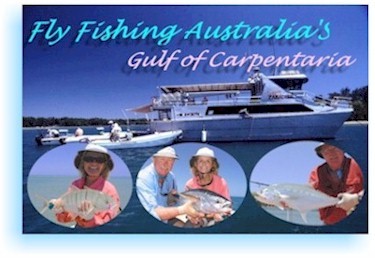

A
Double Header in the Land Down Under
by Dan Blanton
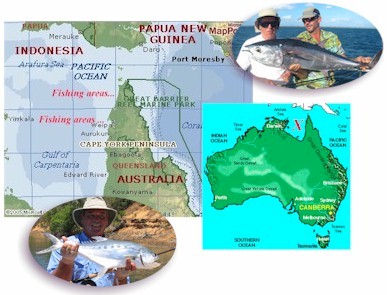 Australiaís
Cape York Peninsula and the Gulf of Capentaria
offers the marine fly-angler one of the last unspoiled angling frontiers in the
world. Its waters teem with an enormous variety of fly-eating species - 54 of
them that can be taken on fly from relatively calm waters that range from
rivers, clear sandy flats and shallow reefs, to calm offshore/nearshore
waters, targeting pelagic species roaming in vast, marauding schools, busting bait
under birds, blowing holes in the surface large
Australiaís
Cape York Peninsula and the Gulf of Capentaria
offers the marine fly-angler one of the last unspoiled angling frontiers in the
world. Its waters teem with an enormous variety of fly-eating species - 54 of
them that can be taken on fly from relatively calm waters that range from
rivers, clear sandy flats and shallow reefs, to calm offshore/nearshore
waters, targeting pelagic species roaming in vast, marauding schools, busting bait
under birds, blowing holes in the surface large
enough to give any angler the
shakes.
|
|
|
|
|
Bill Nash - longtail tuna |
Dan Blanton - longtail tuna |
Terry Schultz - mac tuna |
The Gulf
of Carpentaria has not been over-exploited by
commercial fishing, ravaged by pollution or gone the many other negative ways a
fishery can. It is still remote and wild with very little access except by boat.
Un-crowded is an understatement. Itís beaches are devoid of litter, home only
to birds, animals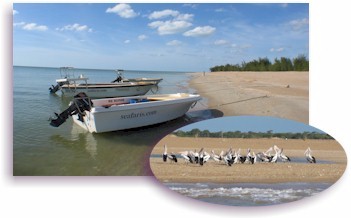 and saltwater crocodiles. Its waters teem with fish. However,
while remote and pristine, the Gulf of Carpentaria is relatively easy to get to
and it, as is all of Australia, is one of the safest places on earth. Of course
youíve heard about the wonderful hospitality and good nature of the folks from
Down Under - it
simply canít be beaten. And, itís great to travel to an exotic angling
destination where the locals speak English - their delightful version of it,
anyhow.
and saltwater crocodiles. Its waters teem with fish. However,
while remote and pristine, the Gulf of Carpentaria is relatively easy to get to
and it, as is all of Australia, is one of the safest places on earth. Of course
youíve heard about the wonderful hospitality and good nature of the folks from
Down Under - it
simply canít be beaten. And, itís great to travel to an exotic angling
destination where the locals speak English - their delightful version of it,
anyhow.
If there is a negative to visiting Ozland, itís that itís a long, tiring flight - about 15 hours from Los Angles to Sydney for us Yanks and another 2-1/2 hours to Cairns where I suggest you spend a day or two just to re-coup from the arduous flight over before continuing on to your angling destination.
The fact that it is a long and costly flight getting there means one profound thing to me: ONE WEEK OF FISHING IS NOT ENOUGH! Go for two and even three if you possibly can. The Gulf and its brilliant fly fishing is more than enough to justify it. With this mindset and because it was the first time Iíd be visiting Australia, I booked a double header in 2002 - a week each with two different operators who had impeccable reputations, both on the Gulf of Capentaria but each offering two distinctly different venues, fishing two different areas of the Gulf. This was also like hedging my bet - if poor weather/water conditions one week hampered my fishing, I could make up for it the second - or I could easily have two blistering weeks of ripping lips. How could I lose!
Game one - Carpentaria Seafaris - 2002
Game one of my double header was with Carpentaria Seafaris. Family owned and operated by Greg Bethune, his father, Joseph Bethune and Gregís partner in life and business, Jennie Fuller, it is a live-aboard "Mother Ship" operation. I rate it as the best of its type Iíve ever experienced or have heard about.
I first learned about Carpentaria Seafaris from long time friend and fishing travel agent, Howard McKinney. Heíd urged me to make the trip for years. I also got first-hand reports from otherís who I knew and trusted. All the positive accolades encouraged me even more to go. The clincher, though, was meeting Greg Bethune in person at the San Mateo, International Sportsmens Exposition. He just exuded professionalism and excitement about his operation and the diverse Gulf of Carpentaria fishery. Of course the action video he showed with many of my friends, men and women, hunkered over bucking fly rods and whooping it up played a major role in the decision-making process. During one of the weeks, a fly-rod group landed 52 different species - all on flies. Made me drool...
A little history and other pertinent information
|
|
|
The 65-foot Tropic Paradise comfortably accommodates 12 guests. On the run down to the start of the fishing area, about a 100 miles, skiffs are transported on the upper deck. Once launched, the upper deck serves as evening lounging area and crew sleeping quarters. |
Greg and Jennie bought their first boat, the Capricorn Mist and started Carpentaria Seafaris in 1991. They towed skiffs behind her and could handle up to six anglers and crew. The operation proved a huge success and Greg soon knew heíd have to build a bigger, faster and better all-round boat. In April of 2002, Greg and Jennie launched theyíre new 65-foot mother ship, Tropic Paradise. The new boatís a beauty, sheís fast, seaworthy, comfortable and now handles up to 12 anglers and a larger crew. The fishing skiffs are now stowed on top which elevates having to towing them down the Gulf to the starting point and back again, saving considerable time. Since the boat was first built, Greg has made further improvements to the Tropic Paradise by adding bulbous bows and extending the hulls out under the fantail to increase speed and weight carrying capacity. She's an absolute beauty!
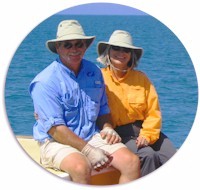 Capentaria Seafaris
encourages women and couples to sign on and
offers two special cabins just for couples. All the remaining cabins sleep two
(bunk beds), are comfortable with AC or fan. The trip is not based on
"double occupancy" but itís best to have a partner, although not
absolutely required. I didnít have one until I arrived - but I was lucky and
drew a great partner, Richard Wright of Fairfax Station, Virginia. Thereís a
large galley, dinning and recreational salon, plus a marvelous top-side deck
(when not occupied by skiffs). The Tropic Star carries plenty of fresh water and
with minimal conservation everyone aboard can take a good shower each day.
Capentaria Seafaris
encourages women and couples to sign on and
offers two special cabins just for couples. All the remaining cabins sleep two
(bunk beds), are comfortable with AC or fan. The trip is not based on
"double occupancy" but itís best to have a partner, although not
absolutely required. I didnít have one until I arrived - but I was lucky and
drew a great partner, Richard Wright of Fairfax Station, Virginia. Thereís a
large galley, dinning and recreational salon, plus a marvelous top-side deck
(when not occupied by skiffs). The Tropic Star carries plenty of fresh water and
with minimal conservation everyone aboard can take a good shower each day.
The crew of the Tropic Star consists of Greg Bethune and Jennie Fuller - owner, skipper guide and hostess; head guide Phil Edwards, one or two additional guides and Emily (Em) - head cook and guide. Em, Jennie and the guides provide sumptuous meals that rival those severed at the finest restaurants. Itís a tough call since all the meals were superb but I have to claim my favorite was the dinner of fresh Mud crabs served at least once during he trip. Thanks Greg and Em, they were luscious!
|
|
|
|
Greg with some dandy mud crabs |
It's worth the trip just for a feed of these |
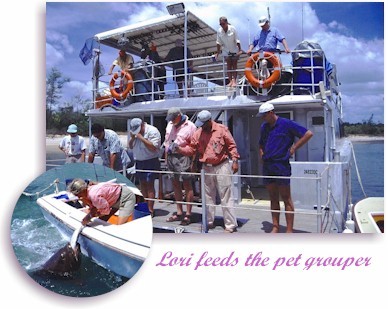 There is also
a full bar with hard liquor, beer, wine and soft
drinks purchased at competitive prices and youíre on the scorecard honor
system. All meals are served aboard including lunch. Coming in for lunch each
day provides an often needed break from rigorous slugfests and to get an update
briefing from Greg who constantly keeps all apprised of whatís going on and
suggests where you might want to fish in the afternoon. If you're lucky
you might also get to feed the pet groupers (gropers in Ozo lingo).
There is also
a full bar with hard liquor, beer, wine and soft
drinks purchased at competitive prices and youíre on the scorecard honor
system. All meals are served aboard including lunch. Coming in for lunch each
day provides an often needed break from rigorous slugfests and to get an update
briefing from Greg who constantly keeps all apprised of whatís going on and
suggests where you might want to fish in the afternoon. If you're lucky
you might also get to feed the pet groupers (gropers in Ozo lingo).
The fishing program
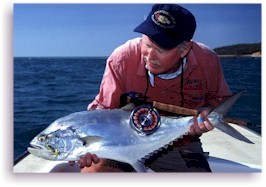 The primary
benefit of booking a trip with a Mother ship
operation is the amount of water that can be fished and extra time spent doing
it. You are living right on top of it. We were awakened every morning with
queenfish and others busting bait all around the boat. Suffice it to say,
breakfast, though splendid, was of secondary importance...
The primary
benefit of booking a trip with a Mother ship
operation is the amount of water that can be fished and extra time spent doing
it. You are living right on top of it. We were awakened every morning with
queenfish and others busting bait all around the boat. Suffice it to say,
breakfast, though splendid, was of secondary importance...
Carpentaria Seafaris has 100 nautical miles of coast and nine
rivers that can be fished. The starting point and rivers visited are based on
the results of the previous trips. The boat runs to its most southern starting
point and then works it way back. It is a self-guided trip. Anglers drive their
own skiffs (two to a boat), although guides are available for one or two days
for those who might not feel comfortable enough with their boating or
fish-locating skills at first to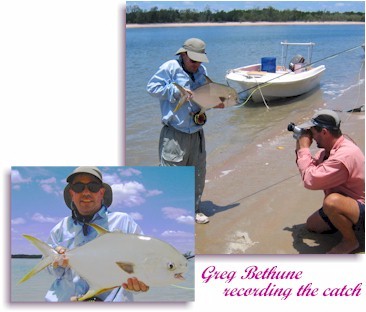 guide
themselves. On the way down, large, white buoys are dropped on key rubble structure, located off the river mouths
in which the mother ship will be anchored.
These buoys are a great aid to the self-guided anglers. Greg also tries to spend
at least one day with each pair of anglers, guiding and video taping their
experiences. Greg provides a personalized video for each angler at tripís end,
a very classy extra which is much appreciated by all. The skiffs are very
seaworthy and fish well. Southeast sea breezes are normally light and flow
offshore, meaning youíll usually have calm seas.
guide
themselves. On the way down, large, white buoys are dropped on key rubble structure, located off the river mouths
in which the mother ship will be anchored.
These buoys are a great aid to the self-guided anglers. Greg also tries to spend
at least one day with each pair of anglers, guiding and video taping their
experiences. Greg provides a personalized video for each angler at tripís end,
a very classy extra which is much appreciated by all. The skiffs are very
seaworthy and fish well. Southeast sea breezes are normally light and flow
offshore, meaning youíll usually have calm seas.
During my
2002 trip, which was typical, we anchored the mother ship
in the Skardon,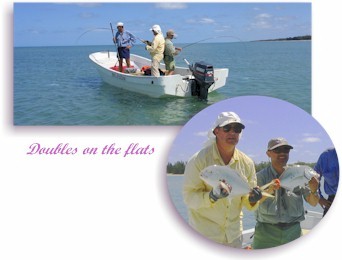 Jackson and Doughboy rivers and on Kerr Reef offshore of the
Skardon. We fished these rivers, adjacent flats, near-by reef structure and the
flats adjacent to other nearby rivers such as the Macdonald, Cotteral, River #2, Crystal
Creek, and the Jardine. The normal game plan is to anchor in two or three
locations during the week and fish at least three rivers, covering others as we
ran back up the coast, skiffs leading the Mother ship or visa-versa.
Jackson and Doughboy rivers and on Kerr Reef offshore of the
Skardon. We fished these rivers, adjacent flats, near-by reef structure and the
flats adjacent to other nearby rivers such as the Macdonald, Cotteral, River #2, Crystal
Creek, and the Jardine. The normal game plan is to anchor in two or three
locations during the week and fish at least three rivers, covering others as we
ran back up the coast, skiffs leading the Mother ship or visa-versa.
A lot of what happens depends upon what the anglers want to do.
After a couple of days of blistering fishing in one area, Greg often asks if the
group wants to stay or try somewhere else. Usually the choice is to try
something new. Itís rare the move proves a bad choice. Greg strives to put
clients into a variety of species and some locations hold more varieties than
others. Some anglers 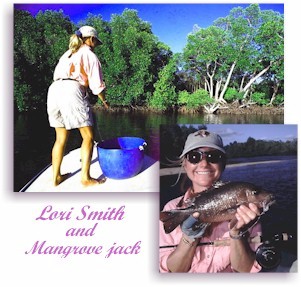 opt to fish the rivers looking for barramundi, jacks,
snappers, queenfish and others. Flats permit and trevally are the focus of
others and for many, like me, the quest was to catch as many different species
as possible on fly and that meant plying the nearshore reef structure and
chasing offshore pelagics. Of course you could do all three, including wading
the flats for permit and others - always keeping a vigilant eye peeled for
saltwater crocs. On the last day of the trip, day eight, the boat is back at
Seisia (about 12 Kilometers form the airport at Bamaga) and happy anglers fly
back to Cairns and hopefully on to game two of their double header.
opt to fish the rivers looking for barramundi, jacks,
snappers, queenfish and others. Flats permit and trevally are the focus of
others and for many, like me, the quest was to catch as many different species
as possible on fly and that meant plying the nearshore reef structure and
chasing offshore pelagics. Of course you could do all three, including wading
the flats for permit and others - always keeping a vigilant eye peeled for
saltwater crocs. On the last day of the trip, day eight, the boat is back at
Seisia (about 12 Kilometers form the airport at Bamaga) and happy anglers fly
back to Cairns and hopefully on to game two of their double header.
Some trip highlights
Wow! Which
ones, there were so many, not only for me and pard,
Richard Wright, but for everyone else in our group. Each day provided new and
exciting piscatorial adventures and highlights were shared by all at lunch and
dinner. Here are a few fishing highlights that stand out for me: There was the
day when Richard and I fished a rubble pile a little north of the Jackson
River, one that Greg had dropped a buoy on. It was warm, sunny and flat and
using LC-13 lead core heads, FT Whistlers and FT Clousers, Richard and I pounded
the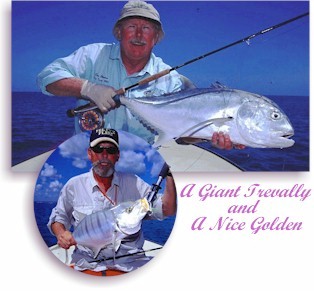 trevally and other species. We landed GTs, golden trevally,
tea leaf
trevally, bludger trevally, queenfish, cobia, snappers and several mackerel
species. The action was non-stop the entire morning and many of the trevally
ranged into the teens and larger. I blew up my 10-weight rod on one GT that I
guessed went 35 to 40 pounds. I hadnít blown a rod on a fish in 30 years and
when this one went, it exploded like a bomb, shattering into several pieces.
Steve Starling and Mike Felton (Felty) were fishing very close by and Steve said
heíd never seen or heard any rod go like that one did. I Couldnít find a
couple of its pieces.
trevally and other species. We landed GTs, golden trevally,
tea leaf
trevally, bludger trevally, queenfish, cobia, snappers and several mackerel
species. The action was non-stop the entire morning and many of the trevally
ranged into the teens and larger. I blew up my 10-weight rod on one GT that I
guessed went 35 to 40 pounds. I hadnít blown a rod on a fish in 30 years and
when this one went, it exploded like a bomb, shattering into several pieces.
Steve Starling and Mike Felton (Felty) were fishing very close by and Steve said
heíd never seen or heard any rod go like that one did. I Couldnít find a
couple of its pieces.
Another highlight for me was getting into the offshore pelagic
action for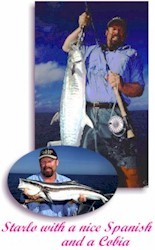 the first time buddy-boating with Steve and Felty. Steve Starling
(AKA Starlo) is
a leading Australian angler, outdoor writer and television fishing personality
whose been on Gregís trip several times. He was a great help to me and others
by offering generous
the first time buddy-boating with Steve and Felty. Steve Starling
(AKA Starlo) is
a leading Australian angler, outdoor writer and television fishing personality
whose been on Gregís trip several times. He was a great help to me and others
by offering generous 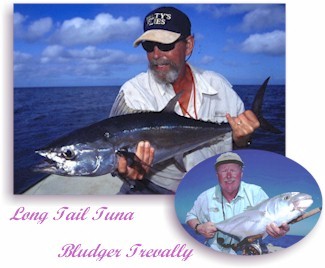 advice and much from his bag of tricks. That morning
Richard got his first longtail tuna and I nailed my first bludger trevally which
I believe fight even harder than the tuna. Chasing those breezing and busting
longtails and bludgers was exhilarating fun. Running and gunning at top speed
across a mild chop made me glad I had brought one of Pro-Trimís Fly Line
Tamers along. It was an immense advantage.
advice and much from his bag of tricks. That morning
Richard got his first longtail tuna and I nailed my first bludger trevally which
I believe fight even harder than the tuna. Chasing those breezing and busting
longtails and bludgers was exhilarating fun. Running and gunning at top speed
across a mild chop made me glad I had brought one of Pro-Trimís Fly Line
Tamers along. It was an immense advantage.
Another Magic moment
was when I hooked a big, hard running fish
over a shallow reef offshore of the Skardon River. This fish got hugely into my
backing and I just knew Iíd hooked a big Spanish mackerel (king mackerel to
us). Turned out to be the largest barracuda Iíve ever hooked on a fly without
the use of chum. It pulled the Boga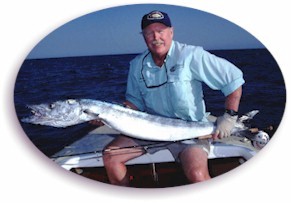 to 30 pounds. Shortly after landing that
fish and on another drift over the reef top, I spotted a big fish surfing toward
us. At first I thought it was a huge cobia but it turned out to be a black
marlin of around 175 pounds. It swam right under the skiff, turned and swam
right back under it again, heading back the way it came. I think it was just
checking us out. You bet we made some casts to it!
to 30 pounds. Shortly after landing that
fish and on another drift over the reef top, I spotted a big fish surfing toward
us. At first I thought it was a huge cobia but it turned out to be a black
marlin of around 175 pounds. It swam right under the skiff, turned and swam
right back under it again, heading back the way it came. I think it was just
checking us out. You bet we made some casts to it!
Another neat highlight was when Richard spotted a nice cobia
surfing down the waves about 80 feet away. Richard wasnít in position to make
a cast but I was. It took about a 90-plus-foot toss but when my Sar-Mul-Mac
landed six feet ahead and to the side of the big cobia, it rushed the fly and
ate it like it was its last meal. What a grab! Too much line, too much stretch -
whatever, I 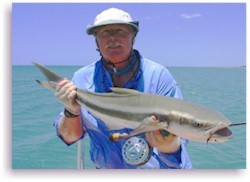 dropped it. It was a great happening, though. Many nice cobia were
also taken off the backs of big rays and they especially liked crab flies. Like I said there were so many highlights
that trying to list them all here would take entirely too much space. However,
of all the highlights the brightest had nothing to do with me.
dropped it. It was a great happening, though. Many nice cobia were
also taken off the backs of big rays and they especially liked crab flies. Like I said there were so many highlights
that trying to list them all here would take entirely too much space. However,
of all the highlights the brightest had nothing to do with me.
Richard and I
were returning to the Tropic Paradise for lunch
when we spotted Steve Starlingís and Feltyís skiff, with Greg Bethune
alongside in his. Greg was video taping Felty fighting a big permit. It was
Feltyís dream-quest to land his first permit on fly, particularly on one of
his own great crab patterns, and he had it on. We rushed over to watch the
event. What a moment when Steve netted the big permit and the deed was done. The
smile on Feltyís face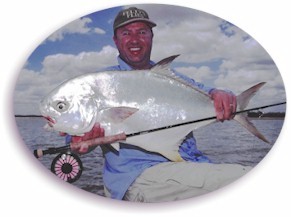 would have illuminated the blackest night. That was the
highlight of the trip for me and I was so pleased to witness the event.
would have illuminated the blackest night. That was the
highlight of the trip for me and I was so pleased to witness the event.
Game one with Carpentaria Seafaris was all I hoped for and expected and then some; and, I believe I can safely say everyone in the group would agree - Itís one of the best angling excursions available today at an incredible price. As a mothership operation, it may well be the best there is for fly fishers and light tackle gear anglers alike.
I Played the double header in the Land Down Under again in 2004, leading a group of 11 anglers, including my wife Cindy. Some of the photos of the action that took place in September of 2004 have been used to illustrate this article, as well as those taken during the 2002 adventure. For a report/summation of the 2004 trip, click on the link below. I've scheduled a return trip for early June of 2006 - Can't wait!
Carpentaria Seafaris Photo Album
Back to Tackle & Techniques page
(c) copyrighted - may not be used in any form without the express permission of Dan Blanton